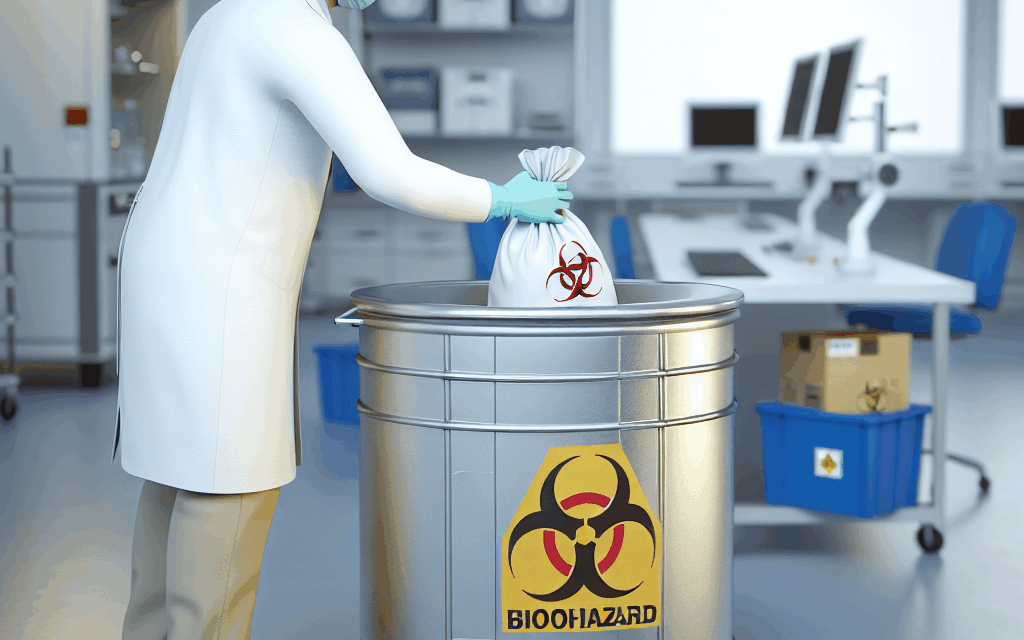Summary: Proper disposal of biohazard waste in clinical laboratories is crucial for safety and compliance with regulations. Common mistakes in segregation, labeling, and disposal, particularly concerning sharps, chemicals, and biohazard waste, can lead to serious consequences. Updates from the EPA and practical advice for laboratory technicians can aid in efficient waste management and adherence to regulations.
Key Takeaways:
- The segregation of biohazard waste requires strict adherence to updated EPA and local guidelines.
- Errors in labeling and disposal can cause safety hazards and non-compliance penalties.
- Jefferson University’s recent study highlights persistent challenges in chemical waste management.
Biohazard Waste in the Lab: Are You Disposing of It Correctly?
In clinical laboratories, safe management of biohazard waste is not just a regulatory requirement—it’s crucial for maintaining a safe environment for staff and patients. Despite established protocols, issues persist in segregation, labeling, and disposal practices. The Environmental Protection Agency (EPA) and local regulations provide comprehensive guidelines, yet lapses in compliance often arise from common mistakes and oversight.
Effective biohazard waste management starts with accurate segregation. According to the Occupational Safety and Health Administration (OSHA), clinical laboratories must categorize waste into bins for sharps, biohazardous materials, and chemicals. Lapses in segregation can lead to cross-contamination and increased risks. For instance, misplacing chemical waste with biohazard waste can evoke both safety hazards and potential fines for non-compliance.
Labeling and Disposal: Persistent Challenges
Accurate labeling of waste is another pivotal aspect. Containers for different waste types must be clearly marked to avoid mishandling. Despite the clarity of guidelines, errors remain prevalent. According to a 2022 study by Jefferson University, 20% of clinical labs experienced mishaps stemming from improper labeling in the past year.
Disposing of sharps incorrectly is a significant concern. They are required to be placed in FDA-cleared sharps disposal containers immediately after use. Failing to do so not only breaches guidelines but poses a significant injury risk to staff. The Centers for Disease Control and Prevention (CDC) recommend reviewing sharps handling protocols regularly to reinforce safe practices.
Disposal practices are under scrutiny, especially with chemical waste. The Resource Conservation and Recovery Act (RCRA) mandates specific protocols for hazardous waste, which include precise documentation and timely removal by licensed waste management services. Despite this, some laboratories face challenges, particularly with mixed waste. Investing in proper training and retaining disposal logs are essential to avoid compliance issues.
Keeping Up with Regulations and Best Practices
Keeping current with evolving standards is critical. Regulatory bodies like the EPA frequently update rules to address emerging risks. Recently, updates on pharmaceutical waste regulation, including hazardous and non-hazardous drug wastes, have been rolled out. Laboratories should ensure their processes are aligned with these updates to mitigate legal risks.
Continuous education is vital. Regular training sessions on waste segregation and disposal can help keep the staff informed about the latest practices and regulations. Additionally, involving employees in routine audits can enhance adherence to safety protocols.
Technology also plays a pivotal role in waste management. Advances in waste disposal systems can streamline processes, ensuring better compliance. Automated tracking of waste from origin to disposal aids in maintaining transparency and identifying potential breakdowns in the disposal chain.
In conclusion, the disposal of biohazard waste in clinical labs requires constant attention to detail and adherence to regulations. By implementing robust training, embracing technological advancements, and diligently following updated guidelines, clinical laboratory technicians can ensure safe and compliant waste management, safeguarding both human health and the environment.




